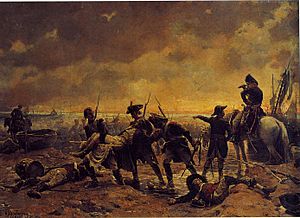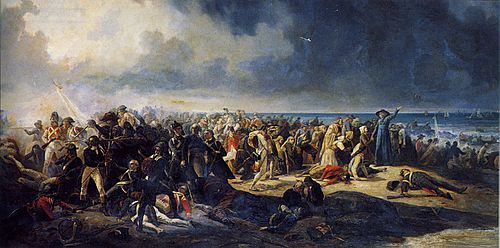Invasion of France (1795) facts for kids
Quick facts for kids Invasion of France |
|||||||
|---|---|---|---|---|---|---|---|
| Part of the Federalist revolts during the War of the First Coalition | |||||||
 Un épisode de l'affaire de Quiberon, by Paul-Émile Boutigny |
|||||||
|
|||||||
| Belligerents | |||||||
|
|||||||
| Commanders and leaders | |||||||
| Strength | |||||||
| 13,000 men | 15,000 Chouans 5,437 émigrés 80 cannons 9 British warships 60 transports |
||||||
| Casualties and losses | |||||||
| Unknown | Around 5,000 dead and 6,332 captured | ||||||
The Invasion of France in 1795, also known as the Battle of Quiberon, was a big landing of troops on the Quiberon peninsula in France. This happened from June 23 to July 21, 1795. The troops were French Royalists who had left France and were supported by the British. They wanted to help the Chouans and the Vendée Revolt, who were fighting against the new French government (the Republic).
The main goal was to start a huge uprising across western France. They hoped to end the French Revolution and bring back the king. However, the invasion failed badly. It was a major defeat for the Royalist cause.
Contents
Planning the Invasion
Before the invasion, the French king, Louis XVIII, and his brother, the comte d’Artois, divided up the plans to fight the Revolution. The comte d'Artois was in charge of western France, including Brittany. He chose Joseph de Puisaye to lead the Royalist forces there. Puisaye was a good choice because he had military skills and experience.
Puisaye worked with the British to plan the attack on Quiberon. But at the same time, another Royalist group in Paris was also making plans. This group sent their own leader, comte Louis Charles d'Hervilly, to join the expedition. D'Hervilly had unclear orders, which meant he could challenge Puisaye's decisions. This caused problems even before the invasion started.
The chosen landing spot, Brittany, was not agreed upon by everyone. Some Royalists preferred to land in the Vendée region. But Quiberon was chosen despite its problems. It was a narrow strip of land with tricky waters. Also, some Royalist soldiers were given British uniforms. This was a bad idea because the local people disliked the British. They also used French prisoners from British ships to fill their numbers. Many of these prisoners did not like the British or the Royalists and would later rejoin the French Republic. The comte d'Artois, who was supposed to be in charge of all Royalist actions in western France, wasn't even asked about the date of the invasion.
The Expedition Begins
Sailing to Quiberon
On June 23, a large fleet set sail. It included nine warships and 60 transport ships. These ships carried about 3,500 Royalist soldiers, along with weapons, uniforms, and supplies for a much larger army. British admirals Hood and Warren led the fleet.
A French fleet from Brest tried to attack the British ships. But the French were forced to retreat quickly. The British kept control of the sea for the rest of the invasion. This was important for the Royalists.
Disagreements Among Leaders
On June 26, the ships arrived off Quiberon. They could have started landing troops right away. But then, comte Louis Charles d'Hervilly showed his orders and said he was in charge. This caused a big problem between him and Puisaye.
The two leaders had different plans. Puisaye wanted to attack immediately to surprise the French Republican forces. He wanted to help the Royalist fighters across western France. But d'Hervilly thought the local Royalist fighters (Chouans) were not good enough for open battle. He wanted to stay at Quiberon, build up defenses, and wait for more troops.
Their disagreement was not just about military plans. Puisaye wanted a king with a constitution, like a modern democracy. D'Hervilly wanted to bring back the old system of absolute monarchy. They argued for a whole day. This delay was very costly. It gave the Republican army time to gather their forces. The Royalist soldiers were confused and impatient. The Chouans, who were waiting to help, began to suspect a betrayal. This delay badly hurt their morale.
Landing the Troops
On the morning of June 27, the mist cleared. The Republican forces saw the British ships in Quiberon Bay. A fort on the peninsula, called Fort Penthièvre, signaled that a large force was landing. British ships also blocked nearby Belle-Île island.
On June 27, the British landed 8,000 troops at Carnac. The landing went smoothly because the local Royalist fighters (Chouans) had already defeated the Republican soldiers in the area. They had taken control of towns like Carnac and Auray.
Fort Penthièvre, which blocked the way north, was held by 700 Republican soldiers. But they gave up easily on July 3. This allowed the Royalist troops to connect with the Chouans. They occupied the local villages. However, Puisaye did not act quickly enough to worry the Republicans.
Republican Counter-Attack
The arguments among the Royalist leaders helped the Republicans a lot. The landed troops were spread out and disorganized. Lazare Hoche, a Republican general, was in Vannes with only 2,000 men. But he quickly marched towards Quiberon, calling for more soldiers along the way. By July 4, he had an army of 13,000 men. The Chouans in the countryside did not slow him down much.
On July 5, Hoche's forces clashed with Chouans at Landevant and Auray, defeating them. Hoche reached Quiberon without much trouble. He turned Carnac into a trap, taking it back on July 6. By July 7, he had retaken almost the entire peninsula. The Chouan groups that were supposed to protect the Royalist positions were easily pushed aside. D'Hervilly did not send help in time. Despite strong attacks, the Royalists could not break through the Republican lines.
Royalist Efforts to Break Out
On July 10 and 11, the Royalists tried to break through the Republican lines. Two groups of Chouans were supposed to sail on British ships and land behind the Republican forces. They would attack from the rear. However, the first group scattered. The second group, led by Vincent de Tinténiac and Georges Cadoudal, was ready to attack. But they received new orders to go to a different landing spot. This was against Cadoudal's advice. Tinténiac was killed in an ambush on July 17. No new landing happened to help them. Angry, the Chouans took off their British uniforms and, led by Cadoudal, managed to escape back to their homes.
Meanwhile, on July 15, 2,000 more Royalist soldiers, led by Charles Eugène Gabriel de Sombreuil, landed at Quiberon. The Royalists launched new attacks but were pushed back. Louis Charles d'Hervilly was badly wounded in one of these attacks. The Royalists had already lost 1,500 men.
The Final Attack on Quiberon
General Lazare Hoche ordered a final attack on the night of July 20. He aimed for Fort Penthièvre, which had 4,000 defenders. A violent storm was raging, and British naval guns were protecting the fort. However, the Republican prisoners who had joined the Royalist side betrayed them. They opened the fort to Hoche's forces. Many defenders were killed. The British ships then fired on the fort, but their shots hit Royalists, Republicans, and civilians alike.
Joseph de Puisaye saw that the situation was hopeless. He ordered his men to get back onto the British ships to save as many as possible. About 2,500 Royalist and Chouan troops were evacuated in British boats. Puisaye was later accused of running away to save himself.
Only Sombreuil and his men were left, trapped. They put up a last fight. But on the morning of July 21, Hoche and Sombreuil began talks. The Royalists surrendered soon after. They believed their lives would be spared.
Aftermath: The Fate of the Prisoners
About 6,332 Chouans and Royalist soldiers were captured. This also included members of their families. General Lazare Hoche had promised that the Royalists would be treated as prisoners of war. But this promise was not kept. The women and children were set free a few days later. However, the soldiers were put on trial.
Charles de Virot, Marquis de Sombreuil, and 750 of his companions were found guilty by a military court. They were then shot by a firing squad at Auray. Many of these men were nobles who had served the king. The place where they were executed is known as the Champ des martyrs (Field of Martyrs). Their remains stayed there until 1814. In 1829, a special chapel was built there to remember them.
A list of the prisoners and the remains of 952 Royalist soldiers are kept at the Chartreuse in Auray. These soldiers died between August 1 and 25, 1795, after the defeat at Quiberon.
In Books and Stories
The Battle of Quiberon has appeared in several books:
- One part of Mr. Midshipman Hornblower (which was also made into a TV episode called The Frogs and the Lobsters) was based on this landing.
- In The Black Moon, a novel from the Poldark series, the main character Ross Poldark uses the landing to help his friend escape from prison.
- The Marquis of Carabas, also known as The Master-at-Arms, by Rafael Sabatini, uses this event as the background for its story.
- The battle is also featured in Sir Isumbras at the Ford, a historical novel by D. K. Broster.
Sources
- Abbé Angot, Quiberon, du 6 juin au 25 juillet 1795, in Revue historique et archéologique du Maine, t. XLI (1897), p. 335-347
- L'Affaire de Quiberon
- Quiberon in the Napoleonic guide


